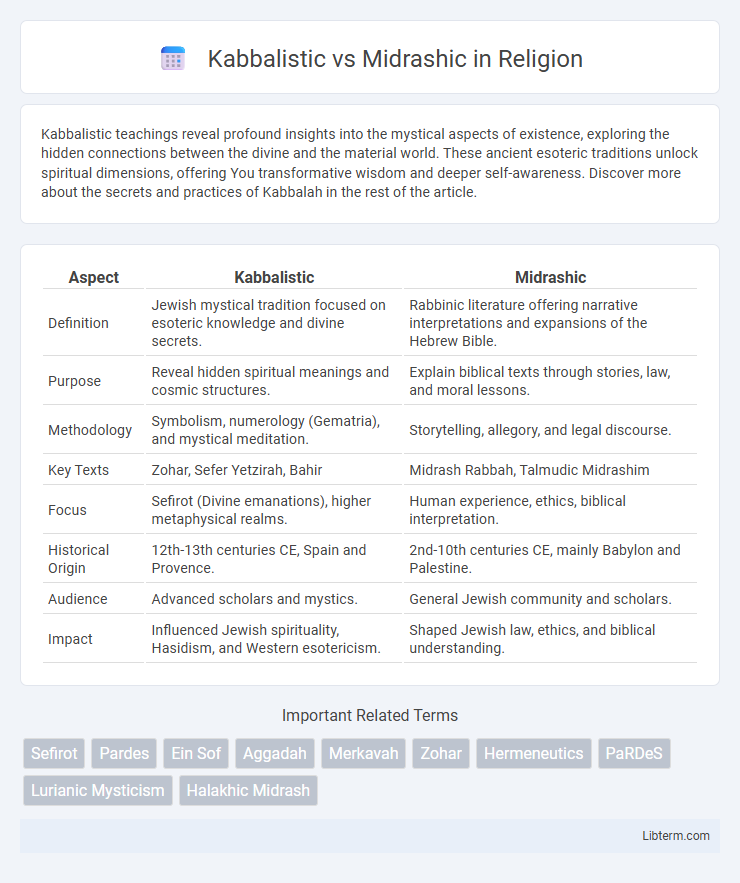Kabbalistic teachings reveal profound insights into the mystical aspects of existence, exploring the hidden connections between the divine and the material world. These ancient esoteric traditions unlock spiritual dimensions, offering You transformative wisdom and deeper self-awareness. Discover more about the secrets and practices of Kabbalah in the rest of the article.
Table of Comparison
| Aspect | Kabbalistic | Midrashic |
|---|---|---|
| Definition | Jewish mystical tradition focused on esoteric knowledge and divine secrets. | Rabbinic literature offering narrative interpretations and expansions of the Hebrew Bible. |
| Purpose | Reveal hidden spiritual meanings and cosmic structures. | Explain biblical texts through stories, law, and moral lessons. |
| Methodology | Symbolism, numerology (Gematria), and mystical meditation. | Storytelling, allegory, and legal discourse. |
| Key Texts | Zohar, Sefer Yetzirah, Bahir | Midrash Rabbah, Talmudic Midrashim |
| Focus | Sefirot (Divine emanations), higher metaphysical realms. | Human experience, ethics, biblical interpretation. |
| Historical Origin | 12th-13th centuries CE, Spain and Provence. | 2nd-10th centuries CE, mainly Babylon and Palestine. |
| Audience | Advanced scholars and mystics. | General Jewish community and scholars. |
| Impact | Influenced Jewish spirituality, Hasidism, and Western esotericism. | Shaped Jewish law, ethics, and biblical understanding. |
Introduction to Kabbalistic and Midrashic Thought
Kabbalistic thought explores the mystical dimensions of the Torah, emphasizing the esoteric meanings of divine emanations and the sefirot, which represent the attributes of God in Jewish mysticism. Midrashic thought centers on interpreting biblical narratives through rabbinic storytelling and allegory, aiming to reveal ethical teachings and legal principles embedded in the text. Both traditions enrich Jewish theology; Kabbalah offers a metaphysical framework for understanding God's hidden nature, while Midrash provides contextual exegesis to illuminate scripture's practical and spiritual lessons.
Historical Origins of Kabbalah and Midrash
Kabbalah originated in 12th-century Provence and medieval Spain as a mystical interpretation of the Torah, emphasizing esoteric knowledge and divine secrets, while Midrash developed earlier during the 2nd to 5th centuries CE as a method of rabbinic biblical exegesis aimed at expanding and explaining scriptural narratives. Kabbalah's roots are linked to the Zohar and mystical texts that reveal hidden dimensions of God, contrasting with Midrashic literature such as the Tannaitic and Amoraic origins focused on ethical and legal teachings. These differing historical origins reflect Kabbalah's mystical framework versus Midrash's interpretative tradition within Jewish thought.
Core Philosophical Differences
Kabbalistic thought emphasizes mystical interpretations of the divine, focusing on esoteric aspects such as the sefirot and the inner spiritual dimensions of scripture. Midrashic teachings prioritize homiletic and ethical lessons derived from biblical texts, often explaining laws and narratives through allegory and rabbinic debate. The core philosophical difference lies in Kabbalah's pursuit of hidden metaphysical truths versus Midrash's aim to clarify and moralize scriptural meanings for practical guidance.
Interpretative Approaches to Scripture
Kabbalistic interpretation of scripture delves into mystical dimensions, emphasizing hidden meanings and esoteric symbolism found within sacred texts like the Zohar. Midrashic approaches focus on expanding biblical narratives through storytelling and legal exegesis, seeking to clarify ethical and theological lessons through rabbinic tradition. Both interpretative methods enrich understanding but diverge by prioritizing mysticism versus legal and ethical exposition.
Symbolism and Allegory: Kabbalah vs. Midrash
Kabbalistic teachings use symbolism and allegory to reveal mystical meanings and hidden spiritual dimensions within the Torah, emphasizing esoteric concepts like the Sefirot and divine emanations. Midrashic literature employs allegory and symbolic narratives to explain biblical stories and laws, focusing on ethical lessons and practical interpretations for everyday life. While Kabbalah delves into cosmic and metaphysical symbolism, Midrashic symbolism serves primarily to elucidate scripture and guide moral conduct.
Views on Divine Mysteries and Revelation
Kabbalistic teachings emphasize the hidden dimensions of divine mysteries, viewing revelation as a multi-layered process where deeper spiritual truths are accessible through esoteric wisdom and mystical experience. Midrashic interpretation focuses on uncovering divine will and moral lessons within the biblical text, presenting revelation as an ongoing dialogue between God and humanity through scripture and ethical teachings. Kabbalah seeks to explore the metaphysical structure of the divine realm, while Midrash prioritizes narrative expansion and practical understanding of Torah commandments.
Influence on Jewish Law and Practice
Kabbalistic teachings deeply influence Jewish law and practice by emphasizing mystical interpretations of commandments, often enhancing ritual observance with spiritual significance. Midrashic literature shapes Halacha by providing narrative expansions and ethical insights that ground legal decisions in scriptural and rabbinic contexts. The interplay between Kabbalah's esoteric symbolism and Midrash's exegetical storytelling enriches the evolving application of Jewish law in daily life.
Key Texts and Authors
Kabbalistic teachings primarily center around foundational texts such as the Zohar, attributed to Rabbi Shimon bar Yochai, and the Sefer Yetzirah, which explore mystical interpretations of the Torah and the nature of divinity. Midrashic literature, including works like Midrash Rabbah and Midrash Tanchuma, comprises rabbinic commentaries that elucidate biblical narratives and laws with ethical and legal insights, penned by early rabbis such as Rabbi Akiva and Rabbi Judah the Prince. These distinct textual traditions represent the mystical and exegetical dimensions of Jewish scholarship, reflecting divergent approaches to scripture and theology.
Modern Interpretations and Applications
Modern interpretations of Kabbalistic thought emphasize mystical dimensions and esoteric symbolism in understanding the nature of God and the universe, often integrating psychological and spiritual healing frameworks. Midrashic approaches in contemporary settings prioritize ethical teachings and narrative expansions, offering moral guidance and insights into biblical texts through storytelling and legal exegesis. Both traditions continue to influence Jewish spirituality, with Kabbalah shaping personal meditation practices while Midrash informs communal values and educational curricula.
Conclusion: Integrating Kabbalistic and Midrashic Perspectives
Integrating Kabbalistic and Midrashic perspectives enriches the understanding of Jewish texts by combining mystical insights with narrative interpretation, offering a holistic approach to spirituality and law. Kabbalistic teachings illuminate the hidden, metaphysical dimensions of scripture, while Midrashic methods provide contextual and ethical clarity through storytelling and exegetical reasoning. This synthesis fosters a deeper connection to tradition, balancing esoteric knowledge with practical application in religious life.
Kabbalistic Infographic

 libterm.com
libterm.com